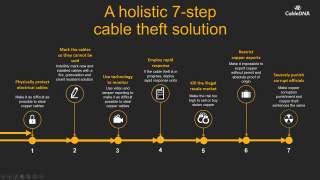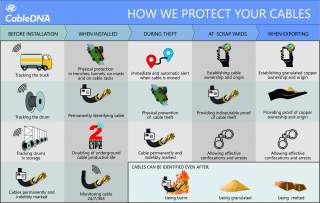A unique new African solution to prevent theft of overhead cables
WHAT HAPPENED
TRANSNET has reported the theft of over 1,000 kilometers of overhead cable from Jan to Oct 2021 - and in the two weeks leading up to 10 November another 55 km was stolen.
See https://www.biznews.com/mailbox/2021/11/16/transnet-copper-cable-stolen for the full story.
THE RESULT
Apart from severe disruptions in services, Transnet is now considering doing away with electric traction and just using diesel in future. That would be an enormous tragedy; not only conceding defeat to gangsterism, but to the environment if many large diesel engines push out their exhaust gases. Much of the goods previously transported by rail now goes by road transport, with hundreds of diesel trucks contaminating the air and damaging the roads.
THE PROBLEM
Only 7% of apprehended thieves are convicted because it is impossible to prove origin and ownership of the cable. Syndicates employ thieves and continue stealing cables knowing they can do so without consequences. Although it is impossible to guard the thousands of kilometers of overhead copper cables, much of it in remote areas, another option is available..
THE SOLUTION
A new South African invention can prevent all this. The solution involves the marking of the top two thirds of the overhead electrical rail cable with nickel microdots, sprayed onto the cables from a slow-moving locomotive. These are the same microdots currently being used to identify vehicles, the use of which 18,000 officials have already been trained. The microdots can never be removed and are impervious to being burnt, being granulated and being melted into ingots.
THE KICKER
With copper cables permanently marked with these microdots, the cables become too risky for scrap yards to buy or for thieves to steal and sell because effective prosecution and conviction becomes possible. Scrap yards will refuse to buy the cable and the illegal copper resale market will be drastically reduced. Even the 250 containers of copper that leave for China and India through Durban harbor every month will be identifiable and illegal exporters prosecuted.
Let’s get it done.
CableDNA is an electrical cable theft prevention company based in South Africa. www.cabledna.co.za
Creating an Integrated Copper Theft Prevention Strategy for South Africa
The way things are
At the moment copper theft is rampant in South Africa. Theft occurs widely and constantly and is costing the country a large fortune. But it gets worse: green energy generation will force us to use more copper. Conventional power generation uses .5 ton of copper per megawatt while wind power generation uses 3.6 ton per megawatt (7 times more copper) and solar power generation uses 4.5 ton per megawatt (9 times more copper) per megawatt. Compounding that, a 10 million ton pa shortage is projected in 20281. We are just not mining copper fast enough and the ore quality is not as good as it used to be. (1)
Carte Blanche has shown the illegal export of copper from South Africa to be R440m every month, a total of : R4.8b every year. This translates to an effective loss of R187b per year and has reduced our GDP growth by in 2020 by 37%.But there is more: the copper price is approaching $10,000 per ton (2) and unemployment is rife. 50% of youth are unemployed and 60% of women are unemployed – and this was before COVID-19. 90% of those in matric at the moment won’t get jobs when they finish school. Unemployment, the high copper price and copper demand will continue conspire to rapidly increase cable theft in South Africa – and cause severe development problems for all of us.
Something has to be done.
The current approach
The current approach to cable theft prevention is a standard one: “my company is the best and we will solve all your problems.” This, of course, is not true. To solve this massive problem requires cooperation to create a combined, holistic solution: Government and Industry combining the best South Africa has to offer to create a uniquely South African solution that works for us.
Hindrances to an Integrated solution
This sounds easy, but it is not. There are many vested interests and wheels within wheels.
- Security companies benefit from cable theft because it keeps security services in demand – and security companies want to be hired
- Cable manufacturing companies benefit from cable theft because stolen cable needs to be replaced – and cable companies want to sell more cable
- Theft solution companies benefit from cable theft because more theft makes our solutions more urgent – and we want to sell our solutions
- Corrupt officials benefit from cable theft because they want theft to continue to let the money keep rolling in
Officials will only implement protection if directly instructed because they are unwilling to make the hard decisions - and cable is often left unprotected. Generally, budgets are limited, so they rather replace than protect cables: so they refuse to pay a little now and are forced to pay much more later.
And all the while South Africa groans under the burden.
Creating a holistic Solution
To efficiently curb cable theft this 7 step approach may be considered:
- Physically protect electrical cables. Make it as difficult as possible to steal them.
- Indelibly mark the cables so they cannot be sold. Ensure that marking method is resistant to being burnt, granulated and smelting.
- As far as possible – and especially at theft hotspots - use technology to monitor the cables. Use video and tamper reporting to make it as difficult possible to steal copper cables.
- Employ rapid response teams. If the cable theft is in progress, deploy the rapid response units
- Destroy the illegal copper resale market. Make the risk to sell or buy stolen copper to high.
- Restrict copper exports. Make it impossible to export copper without permit and absolute proof of origin.
- Severely punish corrupt officials. Make copper corruption punishment and copper theft sentences the same.
How it could work
In order to create a solution both Government and business will have to roll up their sleeves. A Public Private Partnership could be considered as a vehicle for this. Best-of-breed South African solutions and intellectual property could then be identified and combined.
Laws could enforce top-down protection across the board to protect cables. The PPP could provide cable theft protection services to Government, State Owned Enterprises and municipalities. In addition, the PPP could provide protection services to neighbouring countries which also suffer from cable theft.
Advantages
Advantages to Government would include:
- The best technologies would be combined to create a world-class, South African protection solution
- This would be a real solution – not a Band-Aid approach
- Centralised management would allow a top-down approach
- Centralised standards would ensure the best approach and methodology
- Costs would be reduced
Advantages to Industry would include:
- Increased market penetration
- National and regional product distribution
- A real chance to make a lasting difference
It is time to employ a radical solution to the cable theft disease – and the only option is amputation.
Unless we do something about it now, the cable theft problem will ensure that our plans for developing South Africa remain just that – plans.
1. http://www.visualcapitalist.com/the-looming-copper-supply-crunch/
2. https://markets.businessinsider.com/commodities/copper-price
CableDNA is an electrical cable theft prevention company based in South Africa. www.cabledna.co.za
A Holistic new cable theft solution has the world talking
The true cost of cable theft in South Africa is estimated at R187 billion per year – and this was before COVID-19 which forced the already massive cable theft problem through the roof.
Although South Africa is the world leader in cable theft per capita, other countries also suffer. The USA loses almost $1 Billion per year to cable theft and the UK, Latin America and India experience significant copper theft. Copper supply is down and copper prices are rising – all of which do not bode well for South Africa.
In South Africa only 7% of apprehended copper thieves are convicted because cable ownership has to be proven to establish theft and convict the perpetrator. Unemployment, the improbability of prosecution combined with rising copper prices makes the risk acceptable to thieves.
South Africa will continue to feel the effect of loss because of copper theft – and there is no simple solution to this problem. A South African company has developed a world-leading solution to the copper theft scourge – a solution that is causing excitement in various countries. The company integrates patented South African solutions with options other local companies offer to provide a holistic solution to protect cables from manufacturing to installation and even after it has been stolen.
“African problems are best solved by Africans. This breakthrough solution is a world first and we are excited about the acceptance of the solution in other countries” said the CEO of CableDNA. “This unique approach will monitor cables when installed and destroy the illegal copper resale market when the cables are stolen and are being sold. We are proudly South African and our solution is already causing a stir in countries which suffer from cable theft.”
CableDNA is an electrical cable and asset theft prevention company based in South Africa. www.cabledna.co.za
World-first cable theft prevention solution set to destroy the illegal copper resale market
South Africa is experiencing almost 200 instances of cable theft per day.
Although many cable thieves are apprehended, only 7% of offenders are prosecuted because of the difficulty of proving cable ownership. CableDNA - a South African company - has now unveiled a revolutionary cable identification method to overcome the cable identification problem.
Electrical distribution cables (even already installed cables) are infused with a fluid that contains unique microscopic identifiers that can withstand being burnt, being granulated and being melted into ingots.
This approach will make cables treated by CableDNA too risky to steal, buy or sell because effective prosecution of thieves and illegal copper dealers will be inevitable.
In addition, underground electrical cables older than 25 years develop small water-filled channels called “water trees” in the insulation which create a short circuit and cause cable failure. The fluid used by CableDNA to carry the unique identifiers repairs the water trees and restores cable insulation properties to new levels, thereby effectively doubling underground electrical cable life.
South Africa loses an estimated R10 billion per year loss in productivity as well as loss of lives and decreased service provision due to cable theft.
“This is a revolutionary step in the right direction”, an industry CEO said. “South Africa desperately needs solutions like this.”
CableDNA is an electrical cable theft prevention company based in South Africa.





